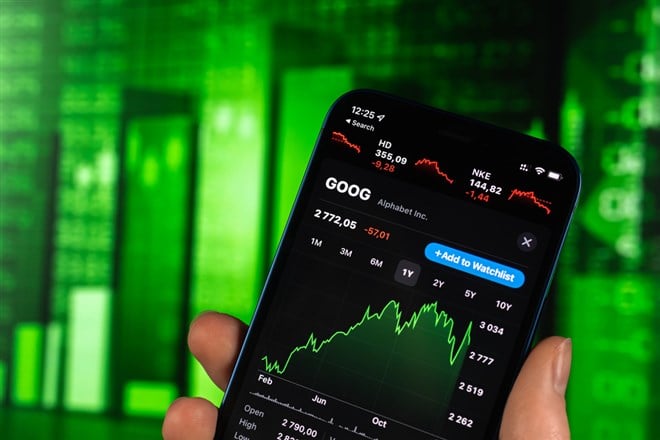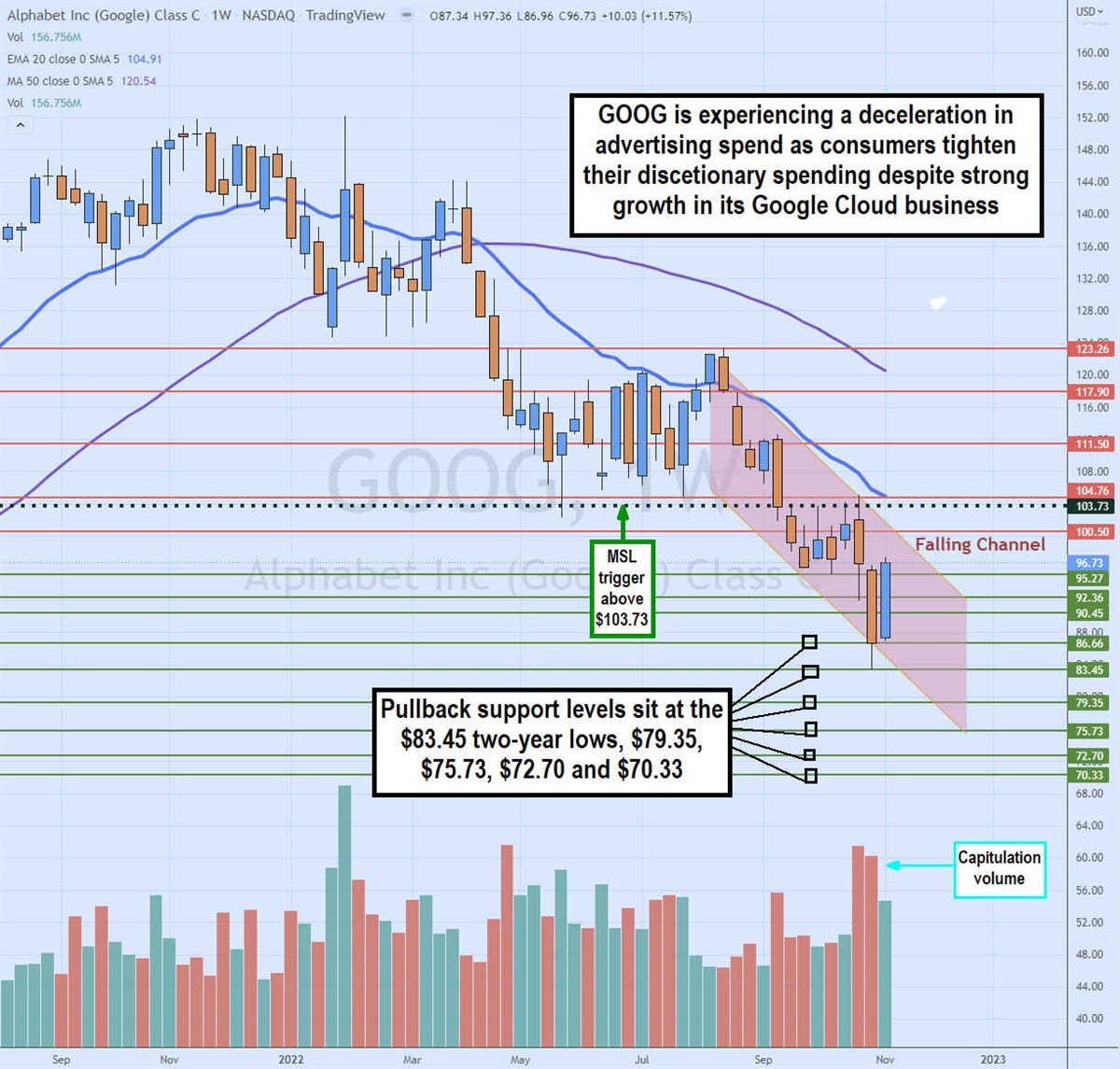 Social media technology provider Alphabet (NASDAQ: GOOG) stock is down (-33%) for the year after rallying 11% off its earnings lows. As complicated as Alphabet and its numerous side ventures can be, it is really just a massive advertising platform powered by the world’s most active search engine Google.com and most active user-created video content delivery service YouTube. Alphabet has numerous side businesses, investments, and projects ranging from the Google Tensor G2 chip used in its line of Pixel smartphones and tablets to Lens translator, DeepMind AI language translations technology to its Waymo autonomous driving division, The growth of hybrid work has driven Google Workspace adoption to over 8 million businesses worldwide. Google Cloud continues to see growth as revenues climbed 38% to $6.87 billion. That sound’s like a lot, but it pales in comparison to the $54.48 billion in Google ad revenues, which only saw 2.5% YoY growth. The strong U.S. dollar made a significant impact as revenue growth came in at 6.1% versus 11% on a constant currency basis, almost double.
Social media technology provider Alphabet (NASDAQ: GOOG) stock is down (-33%) for the year after rallying 11% off its earnings lows. As complicated as Alphabet and its numerous side ventures can be, it is really just a massive advertising platform powered by the world’s most active search engine Google.com and most active user-created video content delivery service YouTube. Alphabet has numerous side businesses, investments, and projects ranging from the Google Tensor G2 chip used in its line of Pixel smartphones and tablets to Lens translator, DeepMind AI language translations technology to its Waymo autonomous driving division, The growth of hybrid work has driven Google Workspace adoption to over 8 million businesses worldwide. Google Cloud continues to see growth as revenues climbed 38% to $6.87 billion. That sound’s like a lot, but it pales in comparison to the $54.48 billion in Google ad revenues, which only saw 2.5% YoY growth. The strong U.S. dollar made a significant impact as revenue growth came in at 6.1% versus 11% on a constant currency basis, almost double.It’s All About the Advertising Revenues
The waning consumer spending as a result of high inflation and weak macroeconomic environment has caused certain advertisers to pull back their spending. This is evidenced across the board on social media sites ranging from Facebook (NASDAQ: META), Snap (NYSE: SNAP), Pinterest (NASDAQ: PINS), and Twitter recently acquired by Tesla (NASDAQ: TSLA) CEO Elon Musk. Many platforms also blame Apple’s (NASDAQ: AAPL) privacy restrictions for causing their ad revenues to sink. Google noted that they saw a pullback in spending in specific industries including financial services, insurance, loan, mortgage, and crypto subcategories. While digital ad spending has been shrinking on social media, they are apparently still strong enough to entice new major video streaming companies like Netflix (NASDAQ: NFLX), Disney+ (NYSE: DIS), and Warner Brothers Discovery (NYSE: WBD) to include cheaper ad-supported subscription tiers to boost memberships and lessen the strain on consumers. Video-ad spending has grown to $76 billion in 2022, up significantly from pre-pandemic levels.
Breaking Down the Numbers
Alphabet released its fiscal third-quarter 2022 earnings report on Oct. 23, 2022. Total earnings came in at $1.06 per share, which missed analyst estimates by (-$0.19) for $1.25 per share. Total revenues only climbed 6.1% to $69.09 billion, which fell short of analyst estimates for $70.67 billion. Operating margins sank to 25% compared to 32% a year ago in the same quarter. The biggest factor driving cost of revenues up by 13% was costs associated with data centers and other operations. The three segments reported the following: Google Advertising revenues rose 2.5% to $54.48 billion, YouTube Ad revenues fell (-1.8%) to $7.07 billion, and Google Cloud revenues jumped 38% YoY to $6.87 billion. The Company expects larger FX headwinds in Q4 and tough comparisons for advertising revenues due to strong growth in Q4 2021.

Here’s What the Chart Says
The weekly candlestick chart has been in a downtrend channel since peaking at $123.26 in August 2022. The weekly 20-period exponential moving average (EMA) formed an inverse pup breakdown on the $117.90 breakdown falling to $104.91 resistance followed by the weekly 50-period MA at $120.54. Shares collapsed on its Q3 2022 earnings report falling to a low of $83.45 on very heavy selling volume that could indicate capitulation, before staging a reversion bounce on the favorable CPI report. The falling price channel indicates a bounce through the upper falling trendline at $100.50 is what bulls are aiming for. GOOG shares will need to breakout through the weekly market structure low (MSL) trigger at $103.73 to face the weekly 20-period EMA at $104.91 to reverse the downtrend. Pullback support levels sit at the $83.45 two-year lows, $79.35, $75.73, $72.70, and $70.33.
Turnaround Catalysts
The top turnaround catalyst would be a bottom and rebound of advertising spend. This can happen is consumer spending rises again, which could be driven by falling inflation from rising interest rates. However, rising interest rates also mean more incentive to save and earn interest in savings and money market accounts. It also means a falling jobs market to content with. Another turnaround catalyst is the fall of the U.S. dollar index, which is already happening as it’s down (-5%) from this years highs. YouTube has jumping on the short-form video wagon that has been popular on Tik Tok and Instagram Reels. However, these types of videos haven’t been able to be monetized for its content creators directly like the regular long-form YouTube payouts through its YouTube Partner Program (YPP). This changed on Sept. 21, 2022, when YouTube announced it will soon pay creators a portion of the advertising revenues it collects on its Shorts video platform starting Feb. 1, 2023. In order to qualify to for Shorts monetization, creators need a minimum of 1,000 followers, 4,000 valid public watch hours in the prior 12 months, or 10 million valid public Shorts views in last 90-days.














